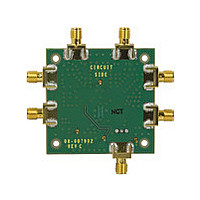AD8349-EVAL Analog Devices Inc, AD8349-EVAL Datasheet - Page 17

AD8349-EVAL
Manufacturer Part Number
AD8349-EVAL
Description
Manufacturer
Analog Devices Inc
Datasheet
1.AD8349-EVAL.pdf
(28 pages)
Specifications of AD8349-EVAL
Lead Free Status / Rohs Status
Not Compliant
SINGLE-ENDED LO DRIVE
The LO input can be driven single-ended at the expense of
higher LO feedthrough at most frequencies (see Figure 48).
LOIN is ac-coupled to ground, and LOIP is driven through a
coupling capacitor from a single-ended 50 Ω source (see
Figure 47).
A 400 Ω shunt resistor on the signal-source side of the ac
coupling capacitor was used for the measurement.
4.0
3.5
3.0
2.5
2.0
1.5
1.0
–1
–2
–3
–4
–5
–6
–7
–8
0
2700
300
LO
Figure 46. Sideband Suppression above 2700 MHz
Figure 45. Sideband Suppression below 700 MHz
Figure 47. Schematic for Single-Ended LO Drive
350
2750
400Ω
400
100pF
100pF
2800
LO FREQUENCY (MHz)
LO FREQUENCY (MHz)
450
USB
5
6
LOIN
LOIP
2850
500
SSB
AD8349
550
2900
SSB
600
USB
2950
650
3000
700
–47
0
–10
–20
–30
–40
–50
–60
–40
–41
–42
–43
–44
–45
–46
–48
Rev. A | Page 17 of 28
RF OUTPUT
The RF output is designed to drive a 50 Ω load, but should be
ac-coupled, as shown in Figure 43, because of internal dc
biasing. The RF output impedance is close to 50 Ω and provides
fairly good return loss over the specified operating frequency
range (see Figure 24). As a result, no additional matching
circuitry is required if the output is driving a 50 Ω load. The
output power of the AD8349 under nominal conditions
(1.2 V p-p differential baseband drive, 400 mV dc baseband
bias, and a 5 V supply) is shown in Figure 7.
OUTPUT ENABLE
The ENOP pin can be used to turn the RF output on and off.
This pin should be held high (greater than 2 V) for normal
operation. Taking ENOP low (less than 800 mV) disables the
output power and provides an off-isolation level of < –50 dBm
at the output.
Figure 49 and Figure 50 show the enable and disable time
domain responses of the ENOP function at 900 MHz. Typical
enable and disable times are approximately 20 ns and
50 ns, respectively.
Figure 48. LO Feedthrough vs. Frequency, Single-Ended vs. Differential LO
–10
–15
–20
–25
–30
–35
–40
–45
–50
–55
–60
–2
–4
–6
–8
8
6
4
2
0
700
0
900
1100 1300 1500 1700 1900 2100 2300 2500 2700
20
Figure 49. ENOP Enable Time, 900 MHz
Drive (Single-Sideband Modulation)
SINGLE-ENDED LO DRIVE
LO FREQUENCY (MHz)
40
TIME (ns)
DIFFERENTIAL LO DRIVE
60
80
AD8349
100
800
600
400
200
0
–200
–400
–600
–800










